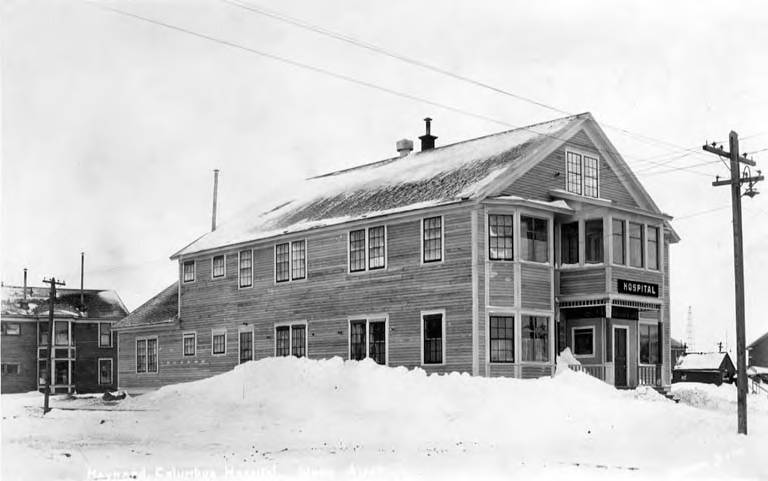Erin K. Crouch
Fairbanks, Alaska, United States

University of Washington Libraries Digital Collections.
Finding gold in 1898 transformed a stretch of tundra just four degrees south of the Arctic Circle into a cabin city of tents, logs, and 20,000 prospectors, including claim jumpers, men of fortune, saloon keepers, and women of ill repute. That marshy patch became Nome, the largest town in the northern territory of Alaska.
Fifteen years later, a narrow-gauge railroad and telephone line from Nome to nearby Anvil Creek was built, along with some much-needed medical infrastructure to support the motley crew living there: the very first hospital. Originally built with twenty-one beds to serve the sick of Nome and the surrounding community, the Maynard-Columbus Hospital in Nome, Alaska, was a simple two-story structure and named for the mayor George Maynard. Photos from the time show it built of plank wood and small paned windows, brought in with great care to a town above the timberline, where no trees grow.
Its sole physician, Dr. Curtis Welch, was assisted by four nurses, one of whom was his wife. Ice-bound for seven months of the year, this rural hospital seems an unlikely place for an event that sparked a world-famous international sporting event.
During that cold, snowy winter of 1925 in Nome, Dr. Welch and the Maynard-Columbus faced an outbreak of diphtheria, a highly contagious upper respiratory tract illness that threatened the region’s ten thousand inhabitants. The local Inuit population was particularly vulnerable to the disease and had been decimated by a flu epidemic just a few years earlier. Although he had been practicing in the north for 18 years, Dr. Welch had never faced anything like the epidemic he now saw: twenty-five cases in the first two weeks and more than twice as many suspected. Setting up a quarantine in the Maynard-Columbus and appointing Nurse Emily Morgan as quarantine nurse, Dr. Welch began to address the emergency at hand.
The hospital’s supply of 8,000 units of vaccine was outdated and quickly exhausted, and on 22 January 1925, Dr. Welch sent a radio telegram via the Washington-Alaska Military Cable and Telegraph System to all major Alaskan cities, and a second to the US Public Health Service in Washington, D.C., reading:
An epidemic of diphtheria is almost inevitable here STOP I am in urgent need of one million units of diphtheria antitoxin STOP Mail is only form of transportation STOP I have made application to Commissioner of Health of the Territories for antitoxin already STOP There are about 3000 white natives in the district.
Aircraft at that time period were water-cooled and not reliable in cold temperatures; the waterways were completely frozen. The only option was to bring the vaccine in by dog sled. On 27 January 1925, 300,000 units of antitoxin were rushed to the town of Nenana in central Alaska by train. Though not enough to completely curb the epidemic in Nome, they would be of vital assistance while more were being shipped from the western U.S.
A relay of twenty dog sled teams, leaving from both Nenana and from Nome and meeting somewhere in the middle near Nulato, began the 630-mile round-trip journey. The first Nenana musher with his precious, 20 lb. package passed it hand-to-hand to the next musher, and so it went, making the trip in a record six days.
Historical monuments and displays across the U.S., including one in New York City’s Central Park, commemorate the bravery and strength shown by the mushers and their dogs during the historic journey. The last musher arrived, clutching the fur-and-canvas wrapped parcel at 5:30 a.m. on 2 February 1925, to save the lives of those lying in the sickbeds of the Maynard-Columbus and throughout northern Alaska. Welch and Morgan inoculated them all by hand, she describing how she wore “woolen underwear, a heavy dress, a sweater, two pairs of woolen hose, a fur parka and mukluks as she walked in subzero temperatures to inoculate residents.”
Today, the Iditarod dog sled race, the most famous mushing event in the world, honors the teams who brought that vaccine so far. Though it burned to the ground in 1948, Alaskans remember the Maynard-Columbus hospital, and the lives it saved.
References
- “History of Nome” On Nome Convention and Visitor’s Bureau Website, n.d. http://visitnomealaska.com/PDF’s/history-of-nome.pdf.
- Tanner, B. “Emily Morgan played crucial role during Alaska diphtheria epidemic.” The Wichita Eagle, March 11, 2013. http://kansas.com/news/local/news-columns-blogs/the-story-of-kansas/article1110701.html#/tabPane=tabs-a85fe415-1.
- Welch, C. “The Diphtheria Epidemic at Nome.” Journal of the American Medical Association, 84(17), 1925: 1290–1291.
- Ungermann, K. A. The race to Nome: the story of the heroic Alaskan dog teams that rushed diphtheria serum to stricken Nome in 1925. Harper & Row, 1963.
ERIN CROUCH has long been fascinated by the merger of medicine and humanities. As a former docent at the Museum of Surgical Science in Chicago and an exhibiter in the “Street Anatomy” Group Gallery Show in 2010 there, and an enthusiastic attendee of Hektoen events such as the “History of Castrati: A Physician’s Perspective,” she is thrilled to write this piece.

Leave a Reply